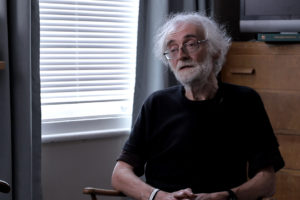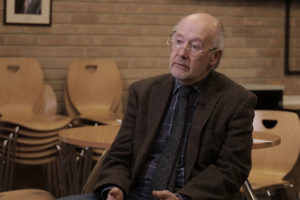Prime Numbers
Mathematician Gareth Jones on number theory, why there are infinitely many of prime numbers and how to calcula...
One of the distinctive features of living things is their sensitivity to the external environment. A very simple demonstration of this can be found in a single-celled animal like an amoeba. If you touch the amoeba, then it will recoil away from the stimulus. This looks like the very basis of the sense of touch because, effectively, in humans, the skin forms a boundary of the body, and we are sensitive to objects that touch the skin; we are aware of the contact of our body with the world around us through the sense of touch.
Neuroscience has investigated in quite a lot of detail how tactile sensitivity works and how we are able to feel the contact between our body and all of the objects in the world around us. One of the most interesting findings is that we do not have one single sense of touch; we really have several because, in the skin, there are many different classes of cells which transduce the mechanical events in the outside world into electrical events in neurons. What does that mean? It means that there are specialised receptors, mechanoreceptors in the skin, which will change their electrical activity as a function of the mechanical contact, the forces applied to the skin by an external object. The electrical activity in the receptor leads to the firing of a neuron, which carries the signal to the brain.
So, what are these different kinds of receptors which give rise to these different submodalities of touch? It turns out that it’s all to do with the morphology, the type of the cell that we have in the skin.
Just to give two examples: we have a cell which goes by the beautiful name of the Pacinian corpuscle which is shaped like an onion, and it’s in the relatively deep layers of the skin. When an object goes across the skin and produces a vibration in the skin, this causes a deformation, a change in shape of all the layers of this onion-like corpuscle which opens ion channels in the neuron and leads to a signal sent to the brain.
So the Pacinian corpuscle is specially arranged to carry signals to the brain about vibrations, about a rapidly changing tactile stimulus. If you look at your fingers, they have a very clear characteristic fingerprint pattern on them, and if you move your fingers over any object with any texture, like my tie, for example, which has got a very fine texture, then you set up a vibration where the hills and valleys in the fingerprint bump against the individual fibres of silk in the tie, and you get a very rapidly fluttering vibration in the skin. The Pacinian corpuscle can follow 250 vibrations per second and send the signal (in this case, from the fingertip of my right index finger) all the way up to the somatosensory cortex in the left hemisphere of my brain.
There are other receptors which respond to completely different stimuli. For example, I’ve been sitting down on this chair for what seems like a very long time, but I can still feel the constant pressure caused by my own body weight on my thighs and on my legs. Those are receptors called Merkel cells, which respond continuously to a sustained pressure which goes on and on and on and can go on all day if I’m standing on my feet.
So you have different sets of receptors in your skin which signal different things, different features of your interaction with the environment to the somatosensory cortex on the opposite side of the body.
The sense of touch is interesting because it allows us to investigate what are the very basic elements of our experience. How do we experience the outside world? What is it that we’re conscious of when we’re conscious?
What we can see when we study tactile sensations is that conscious experience consists of three different things: there are three attributes or three dimensions. I think of probably all conscious experiences. There’s location: where do I feel the touch? Is it on my hand, is it on my face, is it on the soles of my feet? There’s the quality of the sensation: is it more like a vibration, or is it more like a sustained push, sustained pressure? As I’ve told you, the quality of the sensation basically corresponds to which particular receptor cells in the skin are being mechanically impacted by the stimulus in the outside world and which cells in the skin are sending the message to the brain.
The third one after the location and the quality is the intensity: how much signal is arriving at the brain? For example, if I perceive weight by placing a weight on my hand, I can easily tell whether you are placing one kilogram, two kilograms or three kilograms of weight on my hand; I can tell what the forces are because the receptors in the skin will send stronger and stronger electrical messages to the brain as the force on the skin increases.
So the location, the quality and the intensity of tactile sensation all arrive in the brain and they form really the core of conscious experience. That is what allows me to say whether one experience is the same as an experience I had before or whether it’s different.
In my own work, I’ve been interested in how the brain manages to bring together the very different tactile sensations that we have because of the different locations of the receptors in our skin so we can feel an object in our left hand or in our right hand and we have no difficulty in recognising whether it is the same object or not. It’s easy, for example, to recognise whether the object which is touching my left hand is the same as the object which is touching my right hand or not. How can I compare information across these two locations on my skin, which are actually going to different hemispheres of my brain?
We were interested in the sensation of location, and we were interested in how you know how big an object is when it touches your skin. This is particularly a problem because you have many, many more receptors in the skin of your fingertip, for example than in the skin of your arm or of your trunk. So the signal that arrives in the brain when an object like, for example, the tip of this pen has touched on a fingertip is a much stronger signal than when the same object is touched by another part of the body like the skin of the forearm simply because there are more receptors on a fingertip than on the forearm. So, the brain has to somehow deal with that because the brain needs to recognise that this is actually the same object, even though the signal arriving at the brain is very loud on a fingertip but much less loud on the forearm.
We reasoned that one way that the brain must do this is by using information from other sensors to try to interpret the raw signal that arise from the tactile receptors.
We did an experiment where we touched people with two points which were a certain distance apart, either on the hand or on the forearm, and we asked them which distance was bigger, the distance on the hand or the distance on the forearm. And when these distances are, in fact, exactly equal, people tend to perceive the distance on the hand as slightly bigger than the distance on the forearm. That’s because they have more receptors in the skin on the hand than they have on the forearm.
Then, we showed people a distorted image using concave and convex mirrors, which showed them a tiny view of their hand and a very big, grossly enlarged view of their forearm, so we gave them this odd visual experience of their body for a number of minutes. Then we blindfolded them and again asked them which object felt bigger by touch, the object on the hand or the object on the forearm, and the altered, distorted visual experience of their own body changed their interpretation of touch. So before the distorted visual experience, the distance on the hand felt bigger than the distance on the forearm, but after seeing your hands small and your arm large, this effect was reduced so that now these objects felt much closer to being the same size.
That implies to me that when we use our sense of touch to try to understand the world and to try to work out, is that a one-pound coin or a two-pound coin that I’m feeling in my pocket?
We must be using some overall self-representation, some little model in our head of what is our body like, how can I compare the sensation that I get when one part of my body is touched with the sensation that I get when another part of my body is touched, how can I reason or compare different kinds of input across skin which has very different numbers of receptors.
I think to do that; the brain needs to have some model of what the body itself is like; you need to have some very primitive kind of bodily self-consciousness. So raw touch will tell you about location quality and intensity, but to make it useful to perceive objects, you need to have some model of what your own sensory systems, your own skin and body are like to bring all of these tactile signals together.

Mathematician Gareth Jones on number theory, why there are infinitely many of prime numbers and how to calcula...

Psychiatrist Guy Goodwin on the monoamine theory of depression, cognitive behaviour therapy and why some peopl...

Two bacterial pathogens changed their very own cell shape as they adapted to the nasopharynx microbiome